It really was only a matter of time before the cookie crumbles. For those of us who have been digital marketers the past decade, there has always been this knowing that sooner or later the cookie will fall. And that time has come.
The Great Digital Marketing Transformation – When The Cookie Crumbles
The rising privacy concerns have reached the ears of many large corporations, who are already taking measures with projects underway to address this global complaint. It may only be a matter of 1 to 2 years before the complete transformation of digital marketing in a cookieless world is complete.
How can brands, digital marketers, advertisers and all of us in related professions prepare for when the cookie crumbles. Here are some of our input to prepare for the new normal of digital marketing.
#1 – Build Trust Like Never Before
Perhaps we are all to go back to the very basics of what marketing is about. Essentially marketing is the voice, the brand ambassador for a company’s products and services. It is how we let consumers know we have so and so products and services that may solve some of their problems.
At its core, a product or service is created to serve. There is a buyer, a seller and a fair transaction, a fair deal is stuck. Should either party feel they have been cheated, there is no way they would trust enough to go through a second transaction. Worst, they might share with others how they felt they have been cheated. Notably, this goes both ways.
However, for the sake of this article, which is focused on the marketing side of things, the point beings is that: even if the cookie crumbles and you no longer would be able to target potential buyers at granular level, it wouldn’t matter, if the basic values of trust is strong. This goes all the way back to the morale of doing business and marketing from a human-to-human perspective.
#2 – Understand the Unified Data Approach
Data has always been a big guy when it comes to marketing. It wasn’t simply the concepts of DMPs (Data Management Platforms), DSPs (Demand Side Platform), third party data and what not that gave meaning to marketing data.
It was more likely the newness factor that exponentially grew this section of digital marketing. But if we were to take a step back, we would see that marketing has always been about data, frequency of purchase, recency of purchase, correlations based on psychographics and demographic information and much more.
In the past, what marketers would then do with this data sets, would be to project and predict via statistics the effectiveness of certain ads, campaigns and ad copy locations that were likely to be most effective.
Add digital and technology into the mix, and what you get is the more modern concept of ‘Predictive Modelling’. This is basically the more advanced way to process data and information to predict and discover potential buyers. More advanced here, meaning the use of AI (artificial Intelligence) and machine learning.
#3 – Re-prioritise First Party Data
First party data might be a fancy way to put it. Basically, this refers to the concept of CRM (customer relationship management). Traditionally, this may refer to having a personal account manager; which is still heavily in use when it comes to the insurance industry whereby an agent would be assigned to your insurance policy.
Fast forward to today’s digital world, we’re talking more than account executives, but platforms and technological solutions that help you to more effectively store and manage customer relationships.
With the rise in importance of first party data, we can only expect more use of CDP and eDMs. CDP stands for customer data platform, a data warehouse that stores consented customer information. While eDM stands for electronic direct mail.
eDM technologies have advanced in leaps the past couple of years to the point of automation, use of AI and machine learning to dynamically personalise newsletters and much more. To get a more complete understanding of how advanced eDMs are today, take a look at our article here: You’ve Got Mail!
#4 – Give More Importance To Contextual Advertising
The demise of cookies does not however mean the demise of digital advertising. On the contrary, we’re likely to see contextual ads grow like never before.
Marketing has always been about the use of words. As the digital marketing world changes dynamically, the one element that has stayed constant is the copy. In other words, the writing part, the content ideation and creation.
As digital advertising transforms from audience targeting to contextual targeting, we may very well see increasing demands for copywriters, linguists, translators, content creators and perhaps just about all online writers. This is because advertising would become more about targeting ad placements based on semantics, predicted intent based on correlations on the use of language, and this will undoubtable involve the use of AI and machine learning.
In Conclusion – The Privacy-centric digital Marketing Era
As a general rule of thumb, we’re heading towards a privacy-centric digital marketing era. Keep that in mind as a compass, as you prepare for the change and for any of your digital marketing activities for that matter. That should help when you feel uncertain or stuck in a dilemma when making decisions.
“We are fast heading towards a privacy-centric digital marketing era.”

